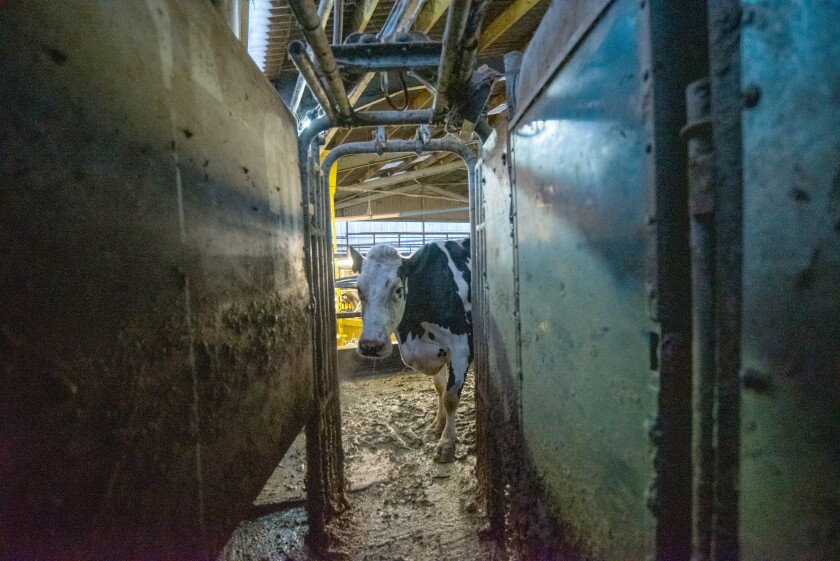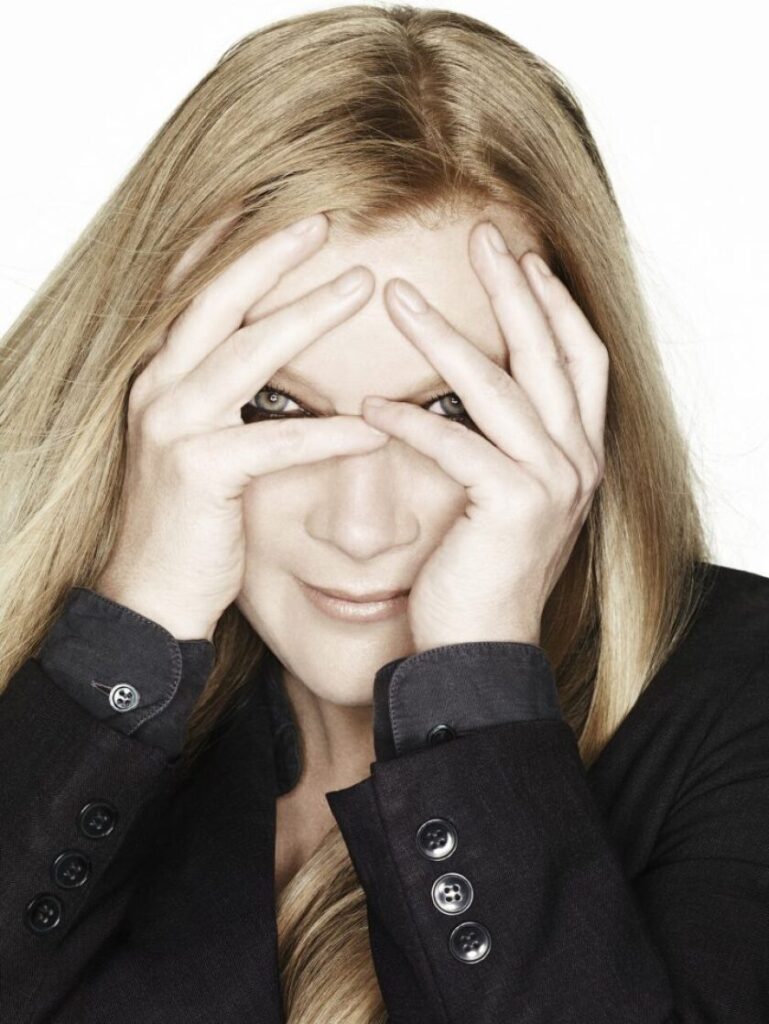“I’m not trying to please anyone,” British filmmaker Andrea Arnold explains, speaking about her work. “I’m trying to just figure something out. And I always have this idea that if you try and figure something out that is your own thing and that it’s an honest endeavor that people will always respond to that, rather than something that’s formulaic.”
While Arnold is referencing her films more generally, the sentiment especially applies to her most recent project, a quiet, introspective documentary called “Cow.” Shot over the course of four years in between other work, including directing the second season of HBO’s “Big Little Lies,” “Cow” is an intimate portrait of a dairy cow named Luma. It follows Luma from the birth of one of her calves to her death at Park Farm in Kent, England, and the filmmaker tapped cinematographer Magda Kowalczyk to help reveal Luma’s inner world. While Arnold wasn’t always sure where the footage would lead, she did have one goal in mind as the project unfolded.
“It was about showing her aliveness,” explains Arnold, whose other films include “American Honey” and “Fish Tank.” “Like, ‘Are we going to be able to see that? Are we going to be able to see the soul?’ Some people would argue, ‘Do we have a soul? What is the soul?’ Probably if you Google it there are a million explanations and some people will say there isn’t one. But there’s no doubt that we all have something that isn’t just our physical self. We have desire, we have feelings, we have thoughts — and we all have our own. John O’Donohue, the Irish poet, says ‘the wild and visible beauty.’ I was trying to show her wild and visible beauty.”
Here Arnold discusses the making of “Cow,” its inevitable ending and how the documentary relates to her previous films.
Andrea Arnold, director of the documentary “Cow.”
(Rankin / IFC Films)
Did the idea for this film come to you from something specific or did it develop over time?
I think the desire to make it comes from quite a long way back. I’ve always had a really big relationship with nature, since I was a kid. I was born on a housing estate [in Dartford, England] and my mom was 16 when she had me — she had four kids by the time she was 22 and my dad was not around. So no one really stopped me from going out, and all around me was this kind of wilderness. And so I roamed from really early on. I think all of us have, left to our own devices, an instinctive relationship with nature.
Living in London — I worked in TV when I first started — I got more and more disconnected from things because, of course, I’m not that kid running around anymore. I realized that living in the city you just get very disconnected, so this film was always sort of brewing. I wasn’t quite sure which form it would take. But then I just thought one day, “Well, I’ll just try to see if I can put a reality to that — the consciousness of one animal. What about if I did that?” That’s where it started with me. I think when I first mentioned it to someone, it was like nine years ago.
How many hours of footage did you shoot?
We filmed for about 30 days a year, over four years. Not every day or anything, but about 30 days each year. So I actually can’t remember how much footage we had. But I went through everything. And we had more because we had to film another cow as insurance in case Luma died suddenly. All that footage was of another cow, God bless her, but we didn’t have to use it. I always had a thing for Luma. And the other cow was lovely. But we did put most of our energy into Luma.
How do you cast a cow?
When we were looking, the farmers would tell me about the cows and they said at the beginning Luma was very feisty. And I thought, “Oh, I like that. She’s feisty, that probably shows some spirit and character.” I liked that she was feisty in that environment because it was almost like a comment. Like it was her spirit coming through. And she had this very lovely, beautiful white head [and] I thought that might make it easier to shoot her and follow her.
There’s a really distinct emotional response that happens when you spend 90 minutes that close to an animal’s face. Was that intentional?
When you think about animals, we use them for their meat or their skins or their bones, or all the things that they physically are. And I wanted to make a movie about the bits you can’t see, you can’t touch — the feelings, the thoughts, the will, the desire. All these things that are in the eyes that are going on, that are part of the aliveness of a being. What I tried to do is to show you something we don’t physically touch or see.
Was that challenging?
The thing is, I think that we can’t know what she’s actually feeling or thinking. But you can get an idea by looking at the eyes. And you can also get an idea by her behavior and the way she responds to things. So I think that’s how you read it: You read it in the way she responds, the way she looks and the way she behaves to her environment and the things that happen.
We can’t know, at all, what she’s thinking. We don’t even know what each other is thinking. We can’t get inside another person’s head. We can’t get inside a beetle’s head. We can’t get inside a cow’s head. So when I talked to Magda, the cinematographer, I said, “Look, we’re just going to show her in her environment, staying with her head, focusing on her, and the way she responds to what happens.” Because I don’t explain anything, or even try to, it leaves things up to [the viewer’s] imagination about what she might be feeling or thinking or desiring. And I think people’s life experiences will be different and they will probably interpret some things differently.

Luma, the subject of the documentary “Cow.”
(Cow Films Ltd./IFC Films)
Did Luma know you when you would arrive to film her?
I didn’t want to pretend that we were not there. They’re used to having humans around because their lives are very managed. But we’re obviously right in her face. And I always said to Magda, “Look, if she does anything, stay there. If something happens and she’s reacting to the camera, keep it running. Let that be part of the film because that’s honest about us being there.” And I think at the beginning she did have a lot of responses to the camera. Sometimes she stared right at us. I felt like her look changed over the time. At the beginning it felt a bit suspicious, a bit more quizzical.
And then towards the end, I felt like she felt seen by us. She felt accepted. Like she was used to it and she felt seen. And I don’t know whether I’m right in that. But I do feel like it’s quite a profound thing, on some level. Because to be seen, what does that actually mean? I don’t think all humans feel seen. Obviously she didn’t know she was being filmed. But we were standing there looking at her and responding to her, having a connection and relationship where when she does something we respond. There’s a connection and an exchange, a sort of consciousness of each other’s existence. I wonder if her being seen and feeling seen meant that she felt her existence more.
When you took this on, were you aware of Luma’s life trajectory and how this story would end?
Well, all dairy cows, once they don’t give milk, are slaughtered. So I didn’t know but that was highly likely where it would end because that’s farm animals’ existences when they’re not useful anymore.
How do you feel “Cow” fits in with the rest of your work?
I made a short [film] called “Milk,” which is about a mom who loses a baby. And I feel like it’s connected to this. Like, it all feels connected. It really does feel part of everything I do. It’s obviously a very different way of making something, but it feels totally connected in terms of what it is and how it is and what it’s about. Somebody today said to me they felt it was weirdly life-affirming but also tough. And I feel like [that] about all my films. Hopefully, they’re a bit of both of those. They cover both — the fact that life can be amazing and joyous, and it can also be quite tough.
What’s more difficult: directing a cow or directing a Hollywood actor?
Cows are just what they are, aren’t they? I think that’s why people are moved by Luma, because she is what she is. And actors, they’re often bringing a lot of personal things to what they do but they’re there representing something. They’re bringing their skills to show you some emotion. And sometimes they go there with the emotion. But Luma is just what she is. Once you’re actually making films you’re just around the camera with people trying to tell a story. Whether it be with a cow or with Hollywood actors, it’s kind of the same thing.

